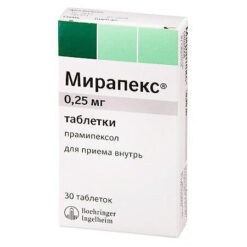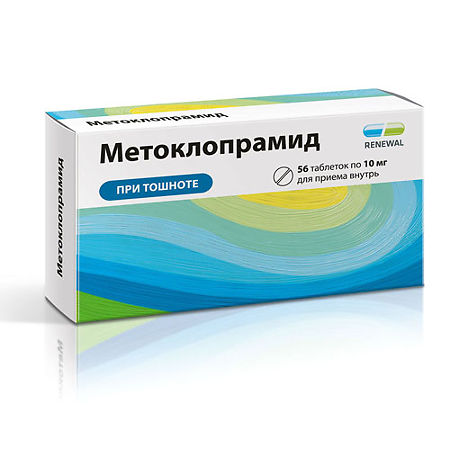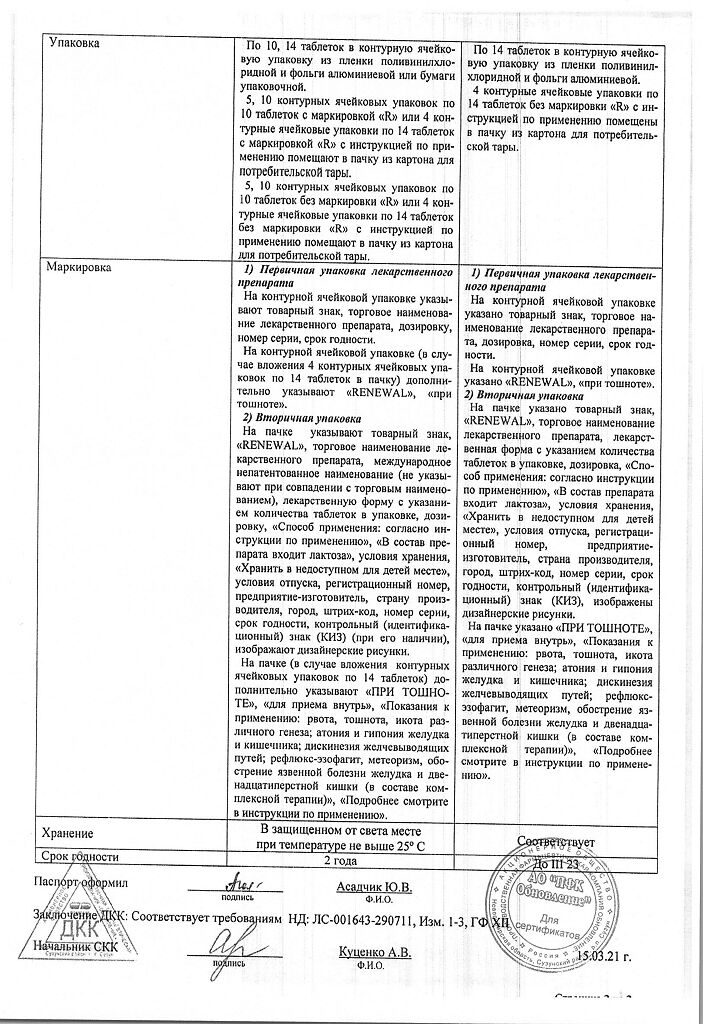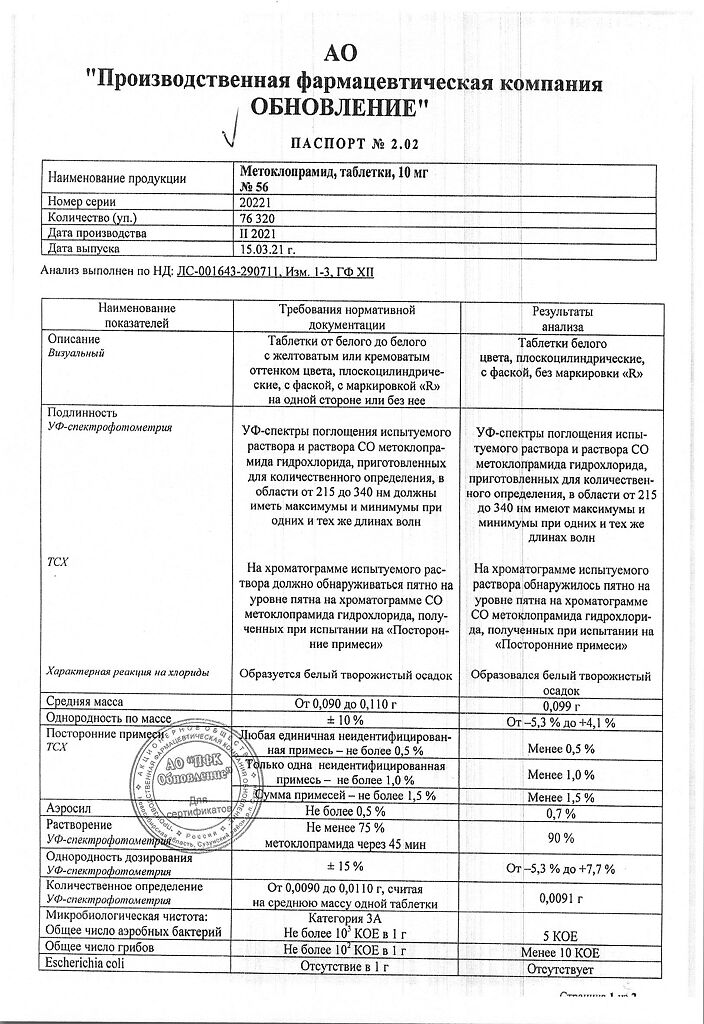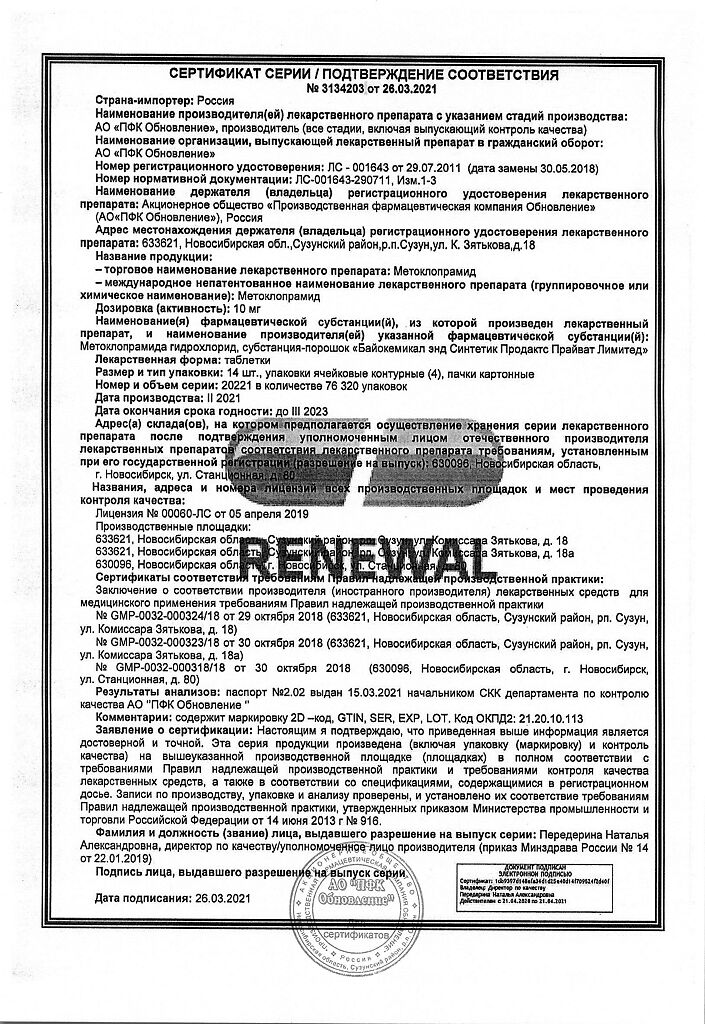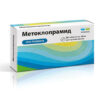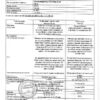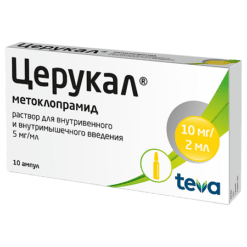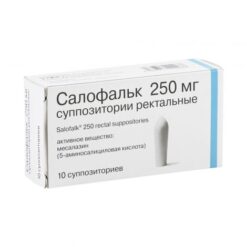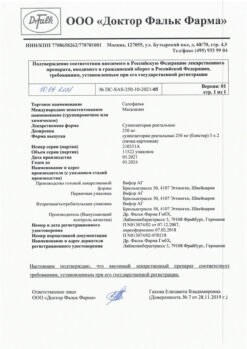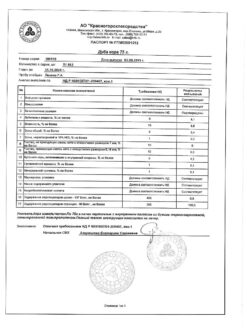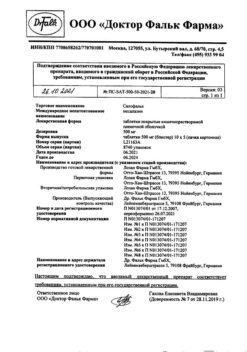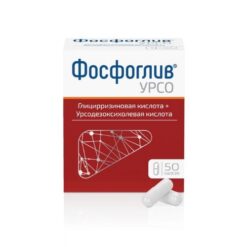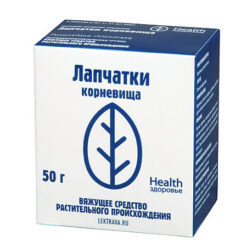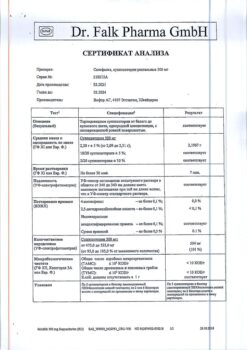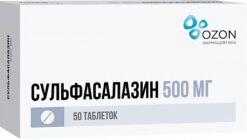Subtotal: €6.92
Metoclopramide, tablets 10 mg 56 pcs
€2.22 €1.92
Pharmacodynamics
Antiemetic, is a specific blocker of dopamine (D2) and serotonin receptors. It has antiemetic effect, eliminates nausea and hiccups. It reduces esophageal motility, increases the tone of the lower esophageal sphincter, accelerates gastric emptying, and also accelerates the movement of food through the small intestine without causing diarrhea. Normalizes the secretion of bile, reduces spasm of the sphincter of Oddi, eliminates gall bladder dyskinesia. It stimulates the secretion of prolactin.
Pharmacokinetics
Fast absorption from the gastrointestinal tract. Bioavailability is 60-80%. Time of maximum concentration achievement in blood plasma is 1-2 hours. The elimination half-life is 3 to 5 hours, with impaired renal function up to 14 hours. The drug is eliminated mainly by the kidneys within 24 hours in unchanged form and as conjugates. Passes through the placental and blood-brain barrier, passes into the mother’s milk.
Indications
Vomiting, nausea, hiccups of various origins (in some cases it can be effective for vomiting caused by radiation therapy or taking cytostatics);
atony and hypotension of the stomach and intestines (in particular, postoperative);
biliary dyskinesia;
reflux esophagitis, flatulence, exacerbation of gastric and duodenal ulcers (as part of complex therapy);
when conducting X-ray contrast studies of the gastrointestinal tract (to enhance peristalsis).
Pharmacological effect
Pharmacodynamics
An antiemetic, it is a specific blocker of dopamine (D2) and serotonin receptors. Has an antiemetic effect, eliminates nausea and hiccups. Reduces motor activity of the esophagus, increases the tone of the lower esophageal sphincter, accelerates gastric emptying, and also accelerates the movement of food through the small intestine without causing diarrhea. Normalizes bile secretion, reduces spasm of the sphincter of Oddi, eliminates gallbladder dyskinesia. Stimulates the secretion of prolactin.
Pharmacokinetics
Rapidly absorbed from the gastrointestinal tract. Bioavailability – 60-80%. The time to reach the maximum concentration in the blood plasma is 1-2 hours. The half-life is from 3 to 5 hours, in case of impaired renal function – up to 14 hours. The drug is eliminated mainly by the kidneys within 24 hours in unchanged form and in the form of conjugates. Passes through the placental and blood-brain barriers, penetrates into mother’s milk.
Special instructions
During the treatment period, it is not recommended to consume ethanol.
If necessary, treatment is carried out with central anticholinergic blockers and other antiparkinsonian drugs.
Elderly patients taking the drug may develop tardive dyskinesia. The risk of developing tardive dyskinesia depends on the duration of the course of pharmacotherapy and the total dose of the drug. Irreversible changes usually develop when the drug is prescribed for more than 12 weeks.
It is not recommended to prescribe the drug for more than 12 weeks, unless the benefits of long-term use of the drug outweigh the potential risks of an adverse reaction. When the drug is prescribed for a short course and in low doses, tardive dyskinesia may also develop, but these changes usually disappear some time after discontinuation of the drug.
The ability to influence the speed of reactions when driving vehicles or working with other mechanisms
During the treatment period, care must be taken when driving vehicles and engaging in other activities that require increased concentration and speed of psychomotor reactions.
Active ingredient
Metoclopramide
Composition
For one tablet:
Metoclopramide hydrochloride monohydrate – 0.0105 g
(in terms of anhydrous) – 0.0100 g
Excipients:
lactose monohydrate (milk sugar) – 0.0660 g
potato starch – 0.0200 g
calcium stearate – 0.0010 g
povidone-K30 – 0.0020 g
colloidal silicon dioxide (aerosil) – 0.0005 g
Pregnancy
The use of the drug is contraindicated in the first trimester of pregnancy. In the second and third trimesters, the drug is used only in cases of extreme necessity, if the potential benefit to the mother outweighs the possible risk to the fetus.
If it is necessary to use the drug during lactation, breastfeeding should be stopped for the entire period of treatment.
Contraindications
Hypersensitivity, bleeding from the gastrointestinal tract, pyloric stenosis, mechanical intestinal obstruction, perforation of the stomach or intestinal wall, pheochromocytoma, extrapyramidal disorders, epilepsy, prolactin-dependent tumors, pregnancy, lactation, children under 18 years of age.
With caution
Bronchial asthma, arterial hypertension, Parkinson’s disease, renal and/or liver failure, old age.
Side Effects
Cardiovascular system: atrioventricular block;
Central nervous system: extrapyramidal disorders – trismus, spasm of the facial muscles, spasmodic torticollis, bulbar type of speech, rhythmic protrusion of the tongue, spasm of extraocular muscles (including oculogyric crisis), muscular opisthotonus, hypertonicity; parkinsonism (muscle rigidity, hyperkinesis – a manifestation of dopamine-blocking action, the risk of development in children increases when the dose exceeds 0.5 mg/kg per day), dyskinesia (in chronic renal failure and in elderly patients), depression, headache, drowsiness, anxiety, fatigue, confusion, tinnitus;
Endocrine system: rarely (with prolonged therapy in high doses) – galactorrhea, gynecomastia, menstrual irregularities;
Digestive system: diarrhea, constipation; rarely – dry mouth;
Hematopoietic system: leukopenia, neutropenia, sulfhemoglobinemia in adults;
Metabolism: porphyria;
Allergic reactions: angioedema, bronchospasm, urticaria;
Other: at the beginning of treatment – agranulocytosis; rarely (when using high doses) – hyperemia of the nasal mucosa.
If the above symptoms appear, worsen, or develop other side effects, you should consult a doctor.
Interaction
When metoclopramide is used simultaneously with certain drugs, the following effects may occur: Ethanol: increased effect on the central nervous system; Cholinesterase inhibitors: weakening of the effect of metoclopramide; Sleeping pills: increased sedative effect; H2-histamine receptor blockers: increasing the effectiveness of therapy; Diazepam, tetracycline, ampicillin, paracetamol, acetylsalicylic acid, levodopa, ethanol: increased absorption; Digoxin, cimetidine: slower absorption; Neuroleptics: increased risk of developing extrapyramidal symptoms.
Before simultaneous use of Metoclopramide with other drugs, you should consult your doctor.
Overdose
Symptoms: drowsiness, confusion, irritability, anxiety, convulsions, extrapyramidal movement disorders, dysfunction of the cardiovascular system with bradycardia and decreased or increased blood pressure. In mild forms of poisoning, symptoms disappear 24 hours after discontinuation of the drug. Depending on the severity of symptoms, it is recommended to monitor the patient’s vital functions. No fatal cases of poisoning due to overdose have been identified.
Treatment: symptomatic. Extrapyramidal disorders are eliminated by slow administration of biperiden at a dose for adults of 2.5-5 mg (biperiden is administered only in a hospital setting, under the supervision of doctors). Diazepam can be used to calm the patient. If large doses of metoclopramide enter the body, gastric lavage is performed, activated charcoal and sodium sulfate are used.
Manufacturer
Update of PFC JSC, Russia
| Manufacturer | Update PFC AO, Russia |
|---|---|
| Medication form | pills |
| Brand | Update PFC AO |
Other forms…
Related products
Buy Metoclopramide, tablets 10 mg 56 pcs with delivery to USA, UK, Europe and over 120 other countries.

